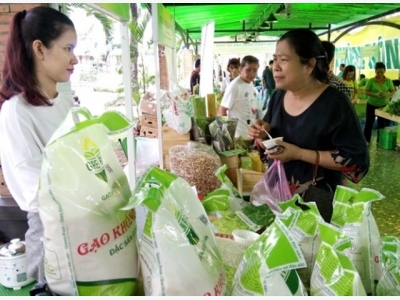Rice exporters advised to prefer quality to quantity

Although they recorded achievements, Vietnamese rice exporters should develop branding, add value to their products, increase connectivity, and diversify products to meet diverse market demands and grow on a sustainable basis. This was the bottom line expressed by participants at an October 17 seminar in Ho Chi Minh City.
Changing market approach
Speaking at the meeting held to discuss Vietnam’s Rice Market Development Strategy from 2017 to 2020, Phan Van Chinh, director of the Ministry of Industry and Trade’s Import-Export Department, said the global rice market had seen changes, with major importing countries increasing domestic production.
“Free trade agreements theoretically create opportunities for Vietnam to boost exports to these markets, but to do so Vietnamese rice must meet the quality standards set by these markets,” he said.
Tran Xuan Long of the Import-Export Department said one of the goals of the 2017-2020 strategy was to gradually reduce rice export volume but increase value.
Between 2021 and 2030, the annual volume is expected to reach four million tonnes, earning US$2.3-2.5 billion. The make-up of the exports will be restructured, with a focus on increasing the export of fragrant, specialty, japonica and high-grade white rice, he said.
Vietnam will focus on Asian and African markets, with China, Bangladesh and ASEAN members such as the Philippines, Malaysia and Indonesia remaining key markets.
Huynh Minh Hue, general secretary of the Vietnam Food Association, said the main varieties of rice traded in global markets are basmati, parboil, fragrant, white broken rice, sticky rice, japonica, and white long-grain rice.
Vietnam is well placed in terms of sticky rice, fragrant, white broken rice, and white long-grain rice, he said. To improve competitiveness, which is one of the measures in the strategy, businesses should focus on improving quality and marketing and cut costs, he said.
Rice traders and exporters should establish links with farmers to ensure supply meets market demand and efficiency, he said.
Pham Thai Binh, general director of the Trung An Hi-tech Farming JSC, said rice traders who have contracted farmers that use safe production processes have bagged export orders from the beginning.
Chinese demand
Nguyen Tien Dung, deputy sales manager of the Loc Troi Group, said accounting for 40 percent of Vietnam’s rice exports, China has become and is expected to be the biggest importer of Vietnamese rice in the end. China accounted for 50 percent of Loc Troi’s rice exports. A number of Chinese enterprises bought Vietnamese rice and mixed it with other rice products to create a different product for sale, and they usually ordered rice with a low price but high quality, good appearance and low humidity. Therefore, creating appropriate rice varieties and learning about the Chinese market’s taste is important to increase export efficiency, Dung said. Loc Troi worked with major Chinese seedling corporations to produce seeds and rice on large fields. The group will be entering joint ventures with other companies to bring its brand rice products to China, he said.
Le Xuan Vinh from the Vietnam Northern Food Corporation (VINAFOOD 1) said 22 enterprises that have been licensed to export rice to China should agree upon rice quality and branding to improve export efficiency.
Do Ha Nam, chairman of the board and general director of Intimex, said Vietnam exported 1.3 million tonnes of sticky rice to China in 2016, which is expected to increase to two million tonnes per annum.
Dang Thi Lien, director of the Long An Food Company, said the company has cooperated with farmers to plant 2,000 hectares of rice and create products meeting importers’ requirements.
Rice production and transportation cost remains high, leading to modest profit for both farmers and exporters. Vinh suggested that the state adopt solutions to improve logistics infrastructure to ease this problem.
Phan Van Chinh, director of the Ministry of Industry and Trade’s Import-Export Department, said that in September, the ministry started implementing the 2017-2020 rice export market development strategy.
Related news
 New method analyzes corn kernel characteristics
New method analyzes corn kernel characteristics New imaging machine helps corn breeders learn number of kernels per ear, plus much more information than can be observed manually.
 Can Tho, India seek partnership in agriculture, training
Can Tho, India seek partnership in agriculture, training Thong said that Can Tho is an agricultural hub of the region with high production and quality of farm produce.
 Vietnamese seedless lime sees great chance to enter Japanese market
Vietnamese seedless lime sees great chance to enter Japanese market Vietnamese seedless lime cultivated in Ben Luc district, the Mekong Delta province of Long An, sees a great opportunity to be exported to Japan.